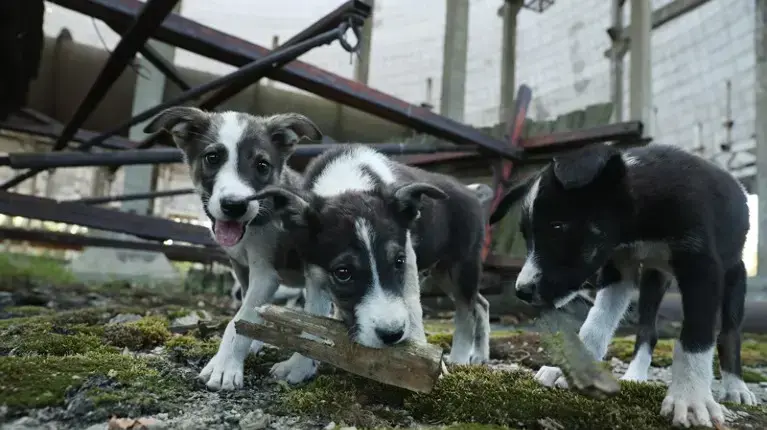This is what the dogs in Chernobyl look like (dogs of Chernobyl)
A new study that examined hundreds of the unleashed dogs roaming the ruins of the Chernobyl nuclear power plant found that exposure to radiation likely caused them to differ genetically from other dogs in the world.
Yes, a kind of mutation is developing in the dog community in Chernobyl - but it's a lot less scary than it sounds.
Following the Chernobyl nuclear disaster on April 26, 1986, approximately 120,000 people living in the surrounding area and in the nearby city of Pripyat were forced to evacuate and abandon their homes.
Some also abandoned their pet dogs, who against all odds survived and managed to establish a robust population that still lives in the radioactive soil surrounding the decaying power plant.
Chernobyl's dogs were found to be genetically different from others (Photo: ShutterStock, Sergiy Romanyuk/Shutterstock.com)
In the new study, scientists were able to gain a deeper understanding of the unusual dog populations living around Chernobyl, given the severe environmental pollution many are exposed to on a daily basis.
Using blood samples collected from the animals roaming the area between 2017 and 2019, they genetically analyzed 302 dogs from the populations living inside the power plant itself - as well as those living 15 to 45 km away from the disaster site. Just by looking at
DNA of the dogs living close to Chernobyl, it was already clear that they are genetically different from pets living in other parts of the world, which researchers believe is a reflection of the ionizing radiation they have been exposed to for generations. More on what is happening in the area What are the frightening discoveries being made in abandoned buildings in
Chernobyl
?
Dozens Years after the disaster: the radioactive elephant's foot still threatens Chernobyl
"We can identify the dogs just by looking at their DNA profile" (Photo: Clean Futures Fund+)
In total, the new study found that this population contained 15 complex family structures that were unique compared to other dogs.
However, it is also clear that the dogs roam the different areas and breed freely with each other.
"I think the most amazing finding from the research is that we identify populations of dogs that live in the wilderness and in its shadow - and we can identify these dogs just by looking at their DNA profile. To think of families living in such places is amazing and indicates the resilience of dogs as a species," she said. Elaine Ostrander, research author and geneticist at the NIH's National Human Genome Research Institute, to IFLScience.
More in Walla!
A model posed half-naked at the "Chernobyl disaster site" and caused an uproar
To the full article
"We also find that the dogs living in the exclusion zone now are likely descendants of pets of people who fled the area when the explosion happened. We can see the history of these pets etched into the DNA of the dogs living in the exclusion zone today," Ostrander explained.
The new dogs? (Photo: Jordan Lapier)
At last count, there may be as many as 800 semi-feral dogs living in the area around Chernobyl, including the heavily contaminated areas like the new Chernobyl Safe Confinement Facility.
The hounds are classified as semi-feral, as they have had some friendly encounters with humans.
Workers and researchers in the area are known to feed the animals, while veterinarians visit the area occasionally to update their vaccinations and treat any medical issues.
This study showed that it is possible to reliably distinguish between the different populations of Chernobyl dogs (Photo: Tim Mousseau)
Now this study has shown that the different populations of Chernobyl dogs can be reliably distinguished.
The researchers hope to test whether the genetic differences have an effect on their health, appearance and behavior.
It could even shed light on genetic mutations that help animals survive radiation, the researchers say.
"Ideally, we'd like to find variants that the DNA has acquired over the 15 generations since the disaster that allow for survival in a high-radiation versus a low-radiation environment," Ostrander explained.
The whole study is still in its early days, but the researchers were very pleased to show how super-detailed genetic analysis can already be done on even a bunch of stray dogs.
"The next phase of this research will involve scaling up our research to the level of the whole genome and its architecture. Again, I cannot stress how revolutionary this is. We have been able to do this type of research for humans and laboratory animals where budgets are high. We are now at the stage where the technology can be applied This is on almost every system everywhere," added Tim Musso, study author and professor of biological sciences at the University of South Carolina.
The article was published in Science Advances.
tourism
Tags
Chernobyl
Seal
Research
dna

